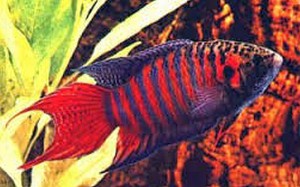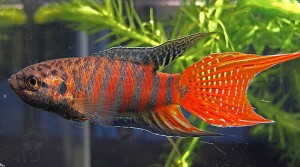Paradise Fish (Macropodus opercularis) are a species of Gourami that is found throughout East Asia, from the Korean peninsula to North Vietnam. There are a number of species of Paradise fish known to tropical fish keeping enthusiasts but the most common are Macropodus Opercularis, Macropodus Ocellatus, and Macropodus Spechti. Of the three, Macropodus opercularis is by far the best known species seen in western tropical fish shops.
All Paradise Fish frequent the marshes, irrigation canals, ditches, rice paddies, and other shallow densely vegetated waters throughout their range where they feed on insects, invertebrates, and fish fry.
Like other species of gourami, Paradise Fish have a labyrinth organ that allows them to breathe air and survive in stagnant, oxygen depleted waters that would normally kill most other species and in an aquarium environment, they need access to the surface of the tank.
Paradise Fish are a brightly colored species that were one of the first ornamental fish available to western tropical fish keeping enthusiasts as early as 1869.
They have alternating turquoise blue and orange stripes that extend into their feather like fins and Betta like tail. There is a spot on the gills and a pattern of dark scales on the head that continues over the back and gradually fades as it goes down the back of the fish.
Males have much longer fins and are more brightly colored than the females.
The Paradise Fish is one of the few species that can change its color in response to stimuli. Its colors becomes darker and more enhanced during combat or when frightened, or lighter colored at will, and it can also be taught though a type of restrictive learning process.
Paradise fish are a pugnacious, highly territorial species that should only be kept with other large, semi aggressive species. They will eat smaller tank mates and are as combative as Bettas therefore, only one male should be kept per tank. They are best housed in densely planted aquarium of at least 30 gallon capacity with a sandy or fine gravel substrate, some smooth rock work and some driftwood or bogwood
for them to hide among. They need adequate filtration with little to no water movement in the tank and because they are great jumpers, it’s a good idea to place a tight fitting cover over their tank.
Paradise Fish can be kept in a community environment with large tetras, some of the less aggressive cichlids (Firemouth Cichlids), Giant Danios, and most of the smaller catfishes. They can also be kept with significantly larger non-aggressive species, like geophagus cichlids, the larger gouramis, and some of the larger synodontis catfishes. Slower moving, long finned species like Angelfish, Bettas, or other male Paradise Fish should be avoided.
Like most Bettas and Gourami, the Paradise Fish is a bubble nest builder. To induce spawning, lower the water level in the spawning tank to about 6″ and increase the water temperature. When conditions are “right”, the male will begin to construct a floating mat of saliva coated air bubbles under floating vegetation or some other plant matter where the eggs will be held for hatching.
The male will begin to make advances toward the female until she is receptive to his open water embrace where both eggs and sperm are released into the water column. After each embrace, the male will gather the fertilized eggs into his mouth and deposit them into the bubble nest. After spawning is complete, as many as 500 eggs may be deposited into the nest where the male guards them until they hatch.
At this point, the female should be removed from the spawning tank or the male will violently attack her and any other fish venturing into the territory of the nest.
When the eggs hatch out and the fry have absorbed their egg sacs, the male should also be removed from the tank. The tiny fry should be fed infusoria until they are able to eat newly hatched baby brine shrimp or finely crushed flake food on their own.
Paradise Fish are omnivores that require both algae based and “meaty” foods. Although they will accept virtually any food, they should be given a relatively high protein diet of live, frozen, or freeze dried mosquito larvae, small flies, black worms, brine shrimp, or tubifex along with a quality algae based flake food.
Paradise Fish are usually readily available in most tropical fish keeping shops when they are 1-3/4″ to 2-1/4″ in size.
Minimum Tank Size: 30 gallons
Care Level: Easy
Temperament: Semi-aggressive
Aquarium Hardiness: Hardy
Water Conditions: 61-79° F, KH 4-18, pH 6.0-8.0
Max Size: 3″
Color Form: Blue, Orange
Diet: Omnivore
Compatibility: OK community tank
Origin: East Asia
Family: Belontiidae
Lifespan: 5-8 years
Aquarist Experience Level: Easy




I would put a pair of paradise fish 5 black skirt tetras,2 Cory catfish and 1 single male austrolebias charruafish.